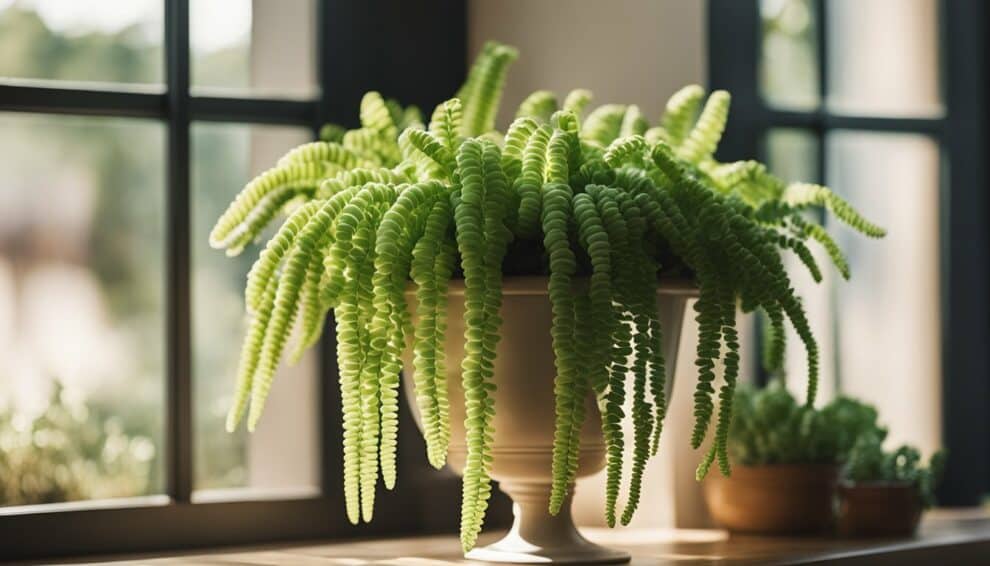Burro’s Tail, also known as Sedum Morganianum, is a popular trailing succulent that is native to Mexico.
Its unique appearance and low maintenance requirements make it a favorite among plant enthusiasts.
However, growing Burro’s Tail can be a bit tricky, as it requires specific care to thrive.

To ensure that your Burro’s Tail grows lush and healthy, it’s important to understand its care requirements.
This article will provide tips and tricks for growing Burro’s Tail, including information on watering, lighting, and soil requirements.
Whether you’re a seasoned plant parent or a beginner, this guide will help you achieve beautiful and thriving Burro’s Tail plants.
Understanding Sedum Morganianum
Species Overview
Sedum morganianum, commonly known as Burro’s Tail or Donkey’s Tail, is a succulent plant that belongs to the Crassulaceae family.
It is native to southern Mexico and Honduras, where it grows in rocky terrain and on cliffs.
The plant is a trailing succulent with long, slender stems that can grow up to 3 feet in length.
The leaves are fleshy and oval-shaped, and they grow in opposite pairs along the stem.
The leaves are a bluish-green color and can turn reddish in bright sunlight.
Historical Significance
Sedum morganianum has been cultivated for centuries for its ornamental value.
It was first introduced to the United States in the early 1900s and quickly became a popular houseplant due to its unique appearance and low maintenance requirements.
In Mexican folklore, the plant is believed to bring good luck and prosperity to the home.
It is also used in traditional medicine to treat a variety of ailments, including headaches, skin irritations, and digestive issues.
Overall, Sedum morganianum is a fascinating and beautiful plant that is easy to care for and adds a touch of natural beauty to any space.
Essential Care Guidelines

Lighting Needs
Burro’s tail thrives in bright, indirect sunlight.
It is best to place the plant in a spot where it can receive at least four hours of sunlight per day.
However, direct sunlight can scorch the leaves, so it is important to avoid exposing the plant to direct sunlight for extended periods.
Watering Practices
Overwatering can be detrimental to the health of Burro’s tail. It is recommended to water the plant only when the soil is completely dry.
This can be checked by inserting a finger into the soil, and if it feels dry, then it is time to water the plant.
It is important to avoid getting water on the leaves as it can lead to rotting.
Soil and Potting
Burro’s tail requires well-draining soil to avoid waterlogging.
It is recommended to use a cactus or succulent mix that contains perlite or sand to improve drainage.
Repotting should be done every two to three years, or when the plant has outgrown its container.
Temperature and Humidity
Burro’s tail is a warm-weather plant that thrives in temperatures between 60 to 75°F (15 to 24°C).
It can tolerate low humidity levels, but it is best to maintain a moderate humidity level to prevent the leaves from drying out.
It is important to avoid exposing the plant to drafts or sudden temperature changes as it can cause stress to the plant.
By following these essential care guidelines, one can ensure that their Burro’s tail will grow into a lush and healthy plant.
Propagation Techniques

Burro’s Tail can be propagated through leaf and stem cuttings. Both methods are relatively easy to do and yield successful results.
Leaf Cuttings
To propagate through leaf cuttings, select a healthy leaf and gently remove it from the stem.
Make sure to leave a small portion of the stem attached to the leaf. Allow the leaf to dry out for a day or two before placing it on top of moist soil.
Cover the leaf with a plastic bag or wrap to create a humid environment. Keep the soil moist and place the cutting in a bright, indirect light.
In a few weeks, small roots should start to grow from the stem and new leaves will appear.
Stem Cuttings
To propagate through stem cuttings, select a healthy stem and cut it into sections about 3-4 inches long.
Remove the bottom leaves from each section and allow the cuttings to dry out for a day or two. Place the cuttings in moist soil, burying about half of the stem.
Keep the soil moist and place the cuttings in a bright, indirect light.
In a few weeks, small roots should start to grow from the stem and new leaves will appear.
It is important to note that Burro’s Tail is a slow-growing plant, so be patient when propagating.
It is also recommended to propagate in the spring or summer when the plant is actively growing.
With proper care and patience, propagating Burro’s Tail can be a rewarding and enjoyable experience.
Troubleshooting Common Issues

Pest Infestations
Burro’s Tail is generally a low-maintenance plant, but it can be susceptible to pests like mealybugs, spider mites, and scale.
These pests can cause damage to the plant, leading to stunted growth, leaf drop, and even death if left untreated.
To prevent pest infestations, it’s important to keep the plant in a well-ventilated area and avoid overwatering.
If you notice signs of pest infestations, such as white cottony spots or webbing, you can use a natural insecticide or a mixture of water and dish soap to get rid of them.
Signs of Overwatering
Overwatering is one of the most common issues that Burro’s Tail owners face. Signs of overwatering include yellowing leaves, mushy stems, and root rot.
To avoid overwatering, it’s important to let the soil dry out completely between waterings.
In general, Burro’s Tail prefers well-draining soil and can thrive in dry conditions.
If you notice signs of overwatering, it’s important to adjust your watering schedule and make sure the plant is in a well-draining pot.
You can also try removing any affected leaves or stems to prevent further damage.
Leaf Drop Causes
Leaf drop is another common issue that Burro’s Tail owners face.
This can be caused by a variety of factors, including overwatering, underwatering, temperature fluctuations, and pest infestations.
To prevent leaf drop, it’s important to keep the plant in a stable environment with consistent temperatures and humidity levels.
You should also avoid moving the plant around too much, as this can cause stress and lead to leaf drop.
If you notice significant leaf drop, it’s important to identify the underlying cause and make the necessary adjustments to prevent further damage.
This may involve adjusting your watering schedule, treating pest infestations, or moving the plant to a more suitable location.
Frequently Asked Questions

How can I propagate my Burro’s Tail succulent for more plants?
Burro’s Tail succulents are easy to propagate. The best way to propagate them is through stem cuttings.
Take a 3-4 inch long stem cutting from the plant and allow it to dry for a day or two.
Once the cut end has calloused over, plant it in well-draining soil and keep it in a bright, indirect light. Water sparingly until new growth appears.
What are the differences between Burro’s Tail and Donkey Tail plants?
Burro’s Tail and Donkey Tail plants are the same plant. They are both common names for the Sedum morganianum succulent.
What steps should I take to revive an ailing Burro’s Tail succulent?
If your Burro’s Tail succulent is looking a bit sad, there are a few things you can do to help revive it.
First, check for any signs of overwatering or underwatering and adjust your watering schedule accordingly. Second, make sure the plant is getting enough light.
Burro’s Tail succulents prefer bright, indirect light. Finally, check for any signs of pests or diseases and treat them accordingly.
What are the ideal light conditions for a healthy Donkey Tail plant?
Burro’s Tail succulents prefer bright, indirect light. They can tolerate some direct sunlight, but too much can cause the leaves to burn.
Is the Donkey Tail plant toxic to pets or humans?
Burro’s Tail succulents are non-toxic to both pets and humans.
However, it’s always a good idea to keep any plant out of reach of pets and small children.
How can I encourage my Burro’s Tail to grow fuller and lusher?
To encourage your Burro’s Tail succulent to grow fuller and lusher, make sure it’s getting enough light and water.
You can also fertilize it with a balanced fertilizer during the growing season to promote healthy growth.
Additionally, pruning the stems can encourage branching and a fuller appearance.














